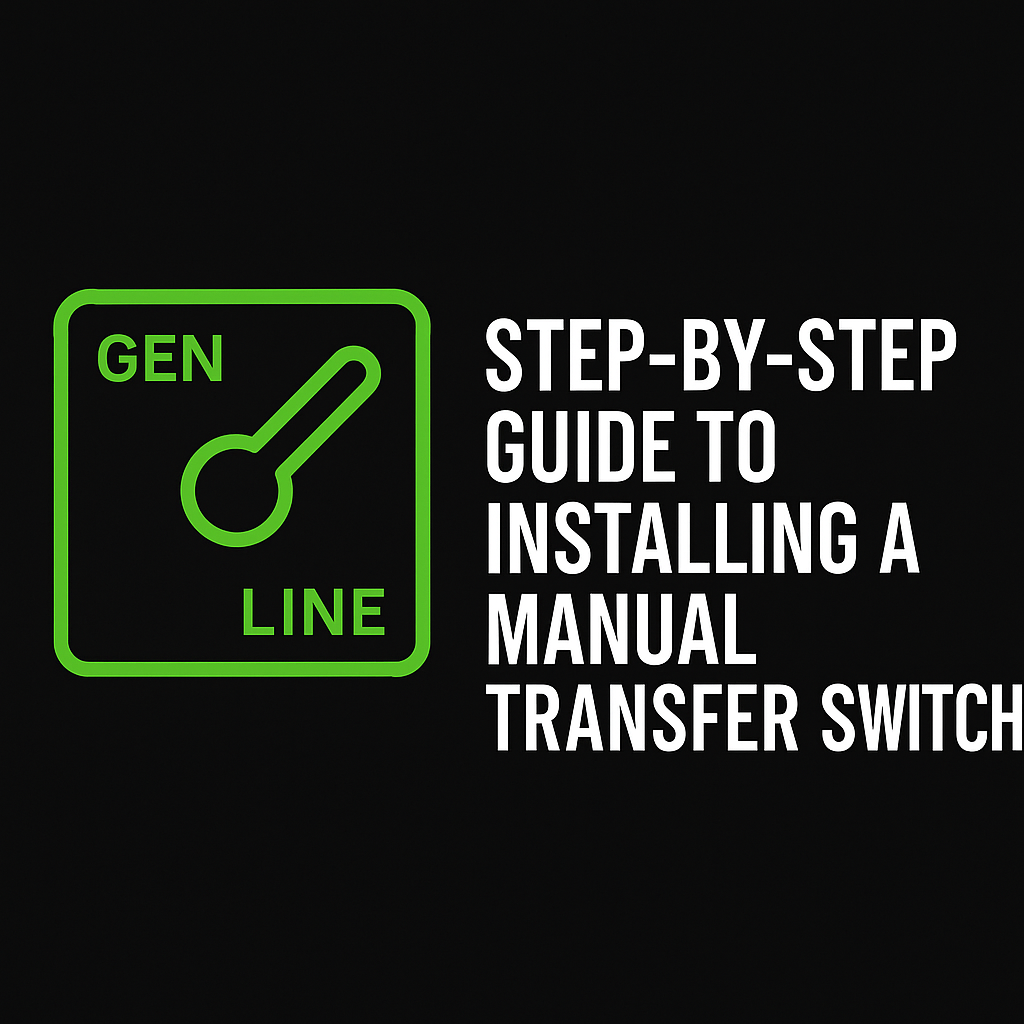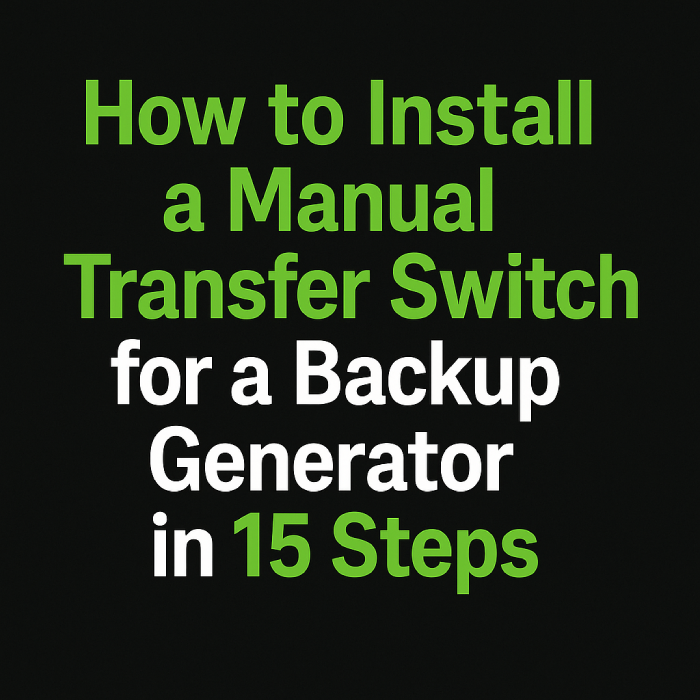Power outages are becoming very common across North America and Canada. As per the latest Federal Energy Regulatory Commission data, U.S. homes experienced over 1.4 billion customer-outage hours in 2024. This is the worst data recorded after they started recording in 2013. Between 2000 and 2024, the United States had 2,319 major outages that affected 50,000+ people. This problem has only grown over the past five years.
This reliability crisis answers the question: Why do you need a home backup power solution? Recently, there has been an increase of 68% of American homeowners who have concerns about long power outages. Out of these, only 17% have functional backup installed. Only a properly connected standby generator can take care of this. But, for that, it needs the safety of an electrical transfer switch for the generator.
For both safety and legal reasons, every permanent generator connection needs to have a transfer switch. The National Electrical Code (NEC) in the U.S. and the Canadian Electrical Code (CEC) made them compulsory for every fixed standby system. Using a properly listed transfer switch not only makes sure of code compliance but also protects your electronics from damage caused by fluctuations.
Tools & Materials Needed for Installation
Before starting with the whole generator transfer switch installation process, get these tools:
Necessary Electrical Tools
- Electrical testing equipment: Digital multimeter or voltage tester (to check if power is off)
- Cutting and stripping tools: Wire strippers, cable cutters, and a utility knife
- Screwdrivers: Complete set of flat-head and Philips head in different sizes
- Wrenches and pliers: Adjustable wrench, needle-nose pliers, and lineman’s pliers
- Power tools: Drill with bits of masonry and wood, hole saw kit (½” to 2”)
- Conduit tools: Conduit bender, reamer, and pipe cutter (if you are using metal conduit)
- Measuring and marking tools: Tape measure, level and permanent marker.
Safety Equipment:
- Electrical safety gloves: Rated for the voltage that you’re working with (usually Class 00 or 0)
- Eye protection: Safety glasses or goggles
- Proper footwear: Rubber-soled work boots
- Fire safety: An ABC-rated fire extinguisher should be nearby
- Warning signs: “Danger – Work in Progress” tags for electrical panels
Required Materials:
- Transfer switch kit: Select a model that is rated for your generator’s voltage and amperage. Common residential options have 120/240v switches, which are rated by 30A (6-8 circuits) or 50A (10-12 circuits). Manufacturers like Generac, Reliance Controls, Square D, and Eaton. Make sure that the switch carries a UL listing (United States) or CSA certification (Canada).
- Generator inlet box: Weatherproof connection point that matches your generator’s output plug.
- Wiring and conductors: For a 30A system, you will need 10 AWG copper wire; for 50A, use 6 AWG wire. The wire colours should include black and red (hot), white (neutral), and green or bare copper (ground).
- Conduit and fittings: EMT (electrical metallic tubing) or a 40 PVC conduit that is of right size for your wire gauge. Along with this, get matching connectors, bushings and locknuts.
- Panel parts: Keep more circuit breakers, wire nuts, anti-oxidant parts (for aluminium connections), and cable clamps.
- Mounting hardware: Screws, anchors, and straps that are right for your wall material (wood studs, concrete, etc.)
- Weatherproofing materials: Silicone sealant, gaskets, and outdoor-rated junction boxes.
Critical Safety Precautions
Working with electrical systems can have serious hazards. All you need to do is follow these safety protocols:
Power Disconnection Protocol:
- Main power shutdown: Turn OFF the main breaker completely before you start working again.
- Verify disconnection: Use a properly rated voltage tester to confirm if power is off at the panel and all the affected circuits.
- Lock-out/tag-out: If possible, lock the main breaker in the OFF position and attach a warning tag.
- Generator isolation: Make sure that your generator cannot start during installation. Just disconnect the starting battery or disable the ignition system.
Regulatory Compliance:
- Permit requirements: Get all electrical permissions before starting work. As of 2025, most North American jurisdictions require permits for generator transfer switch installations.
- Code adherence: Follow current NEC (U.S.) or CEC (Canada) requirements for grounding, conductor sizing, and overcurrent protection.
- Inspection scheduling: Get your work inspected by local authorities once it is completed.
Workspace Safety:
- Dry conditions: Work only when the weather is clear and dry.
- Proper lighting: Make sure your workspace is well lit.
- Tool maintenance: Use only properly insulated tools that are in good condition.
- Protective gear: Wear insulated gloves, eye protection, and the right footwear.
- Emergency response: Keep a fire extinguisher near you and know where your main water shut off.
Risk Assessment:
- Skill evaluation: Honestly assess your electrical knowledge and skills. If you are doubtful, ask a licensed electrician.
- Circuit identification: Know a detailed map of your home’s electrical circuits.
- Load calculation: Calculate the total wattage of circuits you plan to power with your generator to avoid overloading.
Step-by-Step Guide to Installing a Manual Transfer Switch

Step 1: Choosing the Location
The transfer switch location impacts how complicated the installation is and the way it will be used. Think about:
- Proximity to panel: Keep the switch within 2-3 feet of your main electrical panel for easier wiring and less voltage drop.
- Accessibility: Make sure the switch can be reached and can work safely in emergencies, even in the dark.
- Code compliance: Maintain minimum clearances (usually 36” in front, 30” to sides).
- Environmental protection: For indoor installations, choose a dry location. For outdoor placement, use weatherproof spaces.
Most of the residential installations keep the transfer switch near the main panel on an interior wall. If you are mounting outdoors, use a rainproof cover and keep it where it won’t have direct water spray or any mechanical damage.
Step 2: Turning Off the Main Power Supply
This is an important safety step that has to be followed properly:
- Tell household members: Let everyone know in the building that the power will be shut off.
- Save electronic work: Make sure the computers or other sensitive electronics are properly shut down.
- Turn off sensitive equipment: Power down all your major appliances individually before you cut the main power.
- Locate the main breaker: The main disconnect is usually a large double-pole breaker at the top of your panel.
- Shut off power: Make sure to move the main breaker to the OFF position.
- Check power disconnection: Use a properly rated voltage tester to confirm that no power is present at panel busbars and branch circuits.
- Apply lockout/tagout: If possible, secure the tighten the main breaker to avoid any accidental re-energisation.
- Test critical circuits: As a final verification, check different outlets or lights to confirm power is completely off.
Safety Note: Even with the main breaker off, the service conductors entering your panel remain energised. Never touch these wires or their connection points.
Related: The 10 Best Solar Generators of 2025 (Expert-Tested & Reviewed for Every Budget and Need)
Step 3: Preparing Your Electrical Panel
With the power off, you can prepare your panel to be integrated with the transfer switch:
- Remove panel cover: carefully unscrew and remove the cover plate. You will see the interior wiring.
- Identify target circuits: Decide which circuits you want to power in an outage. Usually, the priorities should be:
- Fridge and freezers
- Heating systems
- Well or sump pump
- Selected lighting circuits
- Communications equipment
- Medical devices
- Document existing connections: Take photos and notes of your current panel layout before making changes.
- Create knockouts: Decide where the conduit will enter the panel and make the right knockouts using a punch tool.
- Check for space: Make sure there is enough room for new circuit breakers if it is needed by your transfer switch design.
- Locate the neutral and ground bars: Identify where new neutral and grounding conductors will connect.
When you are selecting circuits for backup power, you should always prioritise important systems. Remember that your generator has a limited capacity, which can power basic appliances but not high-draw ones like electric water heaters or central AC.
Step 4: Mounting the Transfer Switch Unit
A good installation of the transfer switch ensures reliability during emergencies:
- Position the switch: Hold the unit against the wall in the location you have chosen to see if it fits.
- Mark mounting holes: Use the mounting holes as a template to mark drilling locations.
- Prepare mounting surface: For drywall, install the right anchors. Along with these, use masonry bits and anchors.
- Level the unit: Use a bubble level to make sure that the switch is vertical.
- Secure the housing: Attach the space using the right screws or bolts.
- Check stability: See that the unit is anchored and does not move or flex when pressure is applied.
Step 5: Installing Conduit Between Switch and Panel
Proper conduit protects wiring and meets code requirements:
- Measure and plan routes: Decide the shortest practical path between the panel and the transfer switch.
- Select conduit type: Choose EMT (metal) or PVC conduit based on location and local code requirements.
- Size: For most residential installations, ¾” or 1” conduit is enough.
- Cut to length: Measure twice, cut once using the right tools for your conduit material.
- Install fittings: Attach connectors, couplings, and bushings to conduit ends.
- Create bends: Use a conduit bender for metal conduit or heat for PVC to create smooth curves without kinks.
- Mount to surface: Tighten it using appropriate straps at intervals needed by code (usually every 3 feet).
- Connect to space: Install a conduit into the knockouts of both the transfer switch and main panel using proper connectors.
Step 6: Wiring the Transfer Switch to Your Breaker Panel
This stage includes running the main feed wires between your panel and transfer switch:
- Select proper wire: For a 30A switch, use 10 AWG copper; 50A, use 6 AWG copper.
- Prepare conductors: Cut wires to the right length plus 18” of slack at each end.
- Pull wires through conduit: Use fish tape or wire pulling lubricant if needed. Make sure to pull all conductors at the same time.
- Strip insulation: Remove the unnecessary length of insulation from wire ends (usually ¾”).
- Connect to the main panel: Attach wires to a new two-pole breaker.
- Connect to transfer switch: Attach the same wires to the LINE side terminals of the transfer switch.
- Install neutral connection: Run the white neutral wire between the panel’s neutral bar and the transfer switch.
- Complete grounding: Connect a green or bare copper ground wire between the panel’s ground bar and the transfer switch ground terminal.
Step 7: Connecting Individual Circuits to the Switch
Now connect the specific circuits you want to power during outages:
- Identify each circuit: At the main panel, locate each circuit breaker and circuit wire to be connected to the transfer switch.
- Label for reference: Attach temporary labels to help track wires during the process.
- Disconnect from the panel: Turn off each circuit breaker and disconnect the hot wire.
- Extend wires if needed: If it is necessary, add wire length using the right wire nuts and matching gauge wire.
- Connect to transfer switch: Run each circuit wire to its designated position in the transfer switch (labelled as “LOAD”).
- Maintain phase balance: Distribute circuits evenly between the two poles of 240V service.
- Secure connections: Tighten all terminal screws to the manufacturer’s specifications.
- Test connections: Gently tug on each wire to check attachment.
Step 8: Grounding the Manual Transfer Switch
Correct grounding is important for both safety and proper operation:
- Verify existing grounding: Make sure your main panel is properly grounded to the building grounding electrodes.
- Connect ground wire: Run a ground conductor (usually green or bare copper) between the main panel ground bar and the transfer switch ground terminal.
- Size correctly: Use a grounding conductor sized according to NEC Table 250.122 (usually 10 AWG for 30A, 8 AWG for 50A)
- Check neutral bonding: In most residential installations, the neutral-to-ground bond should exist only in the main service panel.
- Check transfer switch settings: Some transfer switches have neutral-ground bonding for proper configuration.
- Test continuity: Use a multimeter to check continuity between the transfer switch area and ground.
- Document connections: Record ground wire routing and connections for later.
The 2023 NEC and 2024 CEC have specific requirements for the grounding and bonding of transfer equipment. Generally, the transfer switch area has to be grounded, but the neutral conductor should only be bonded to ground at one point in the system to avoid a parallel current path.
Related: 6 Best Generators for Home in 2025 to Keep the Lights On During Outages
Step 9: Installing the Inlet Box for Generator Connection
The inlet box provides a safe connection point for your portable generator:
- Select location: Choose an exterior location where it is accessible to you. (usually 5-15 feet away)
- Ensure clearances: Position the inlet at least 18” above ground level and away from windows, doors, and vents.
- Mark the mounting holes: Use the inlet box as a template for marking screw positions.
- Create a wall opening: Cut a hole for wires to pass through the wall if necessary.
- Install weatherproof backing: Apply weatherproof gaskets or sealant around the opening.
- Mount the box: Tighten the inlet box to the wall using appropriate fasteners.
- Seal penetrations: Apply outdoor-rated silicone sealant around any wall penetrations.
- Connect conduit: Run weatherproof conduit from the inlet box to the transfer switch.
Step 10: Running Wiring from Transfer Switch to Inlet Box
Connect your generator inlet to the transfer switch:
- Select appropriate cable: Use the same gauge wire as the main feed (10 AWG for 30A, 6 AWG for 50A)
- Pull conductors: Run two hot wires (black and red), one neutral (white), and one ground (green) through the conduit.
- Connect to inlet: Attach wires to the corresponding terminals in the inlet box.
- Verify polarity: Double-check that hot, neutral, and ground wires connect to the correct terminals.
- Connect to transfer switch: Attach the other ends to the “GENERATOR” terminals on the transfer switch.
- Secure connections: Tighten all terminals to specification and test for tightness.
- Label conductors: Mark wires to indicate function (L1, L2, N, G)
Step 11: Finalizing All Connections and Securing Components
Before testing, you should check that everything was installed correctly:
- Inspect all terminals: See that all connections are tight and secure.
- Check wire routing: Make sure no wires are pinched, stretched, or exposed.
- Verify strain relief: Confirm that cable clamps or connectors are properly holding the wires.
- Install covers: Replace any temporary covers on junction boxes or connections.
- Secure enclosures: Close and fasten all access panels except those needed for testing.
- Weather protection: Make sure that all outdoor parts are properly sealed against moisture.
- Test mechanical operation: Without power, check that the transfer switch mechanism moves freely.
- Document connections: Take final photos of the completed installation for the future.
Pay special attention to wire routing. Keep conductors neatly arranged and grouped, using wire ties if necessary. But avoid overtightening, which can damage insulation. Maintain proper wire bending radius (usually at least 5x the wire diameter) to prevent insulation damage.
Related: 10+ Best Portable Generators for Reliable Power Anytime, Anywhere (2025 Updated)
Step 12: Labelling All Switches and Circuit Breakers
Detailed labelling increases safety and usability:
- Label each circuit: Mark every circuit position on the transfer switch with its function (eg, “Kitchen”, “Furnace”, “Well Pump”).
- Create a load chart: Document the wattage requirements of each connected circuit.
- Mark breakers: In the main panel, label the breakers that feed the transfer switch.
- Add operation instructions: Attach simple step-by-step instructions for switching to generator power.
- Identify generator requirements: Note down the type of generator connection and the minimum wattage needed.
- Apply warning labels: Add safety warnings about backfeeding hazards.
- Include emergency contacts: List the electrician’s contact information for later.
Your labelling should be clear enough that anyone in the household can safely operate the system during an emergency, even in low-light conditions.
Step 13: Inspecting and Verifying Your Installation
Before restoring power, perform this safety checklist:
- Visual inspection: Examine all wiring for proper routing, connections, and insulation.
- Mechanical verification: Check that all screws, bolts, and mechanical fasteners are secure.
- Insulation integrity: Verify no bare conductors are exposed.
- Foreign objects: Make sure no tools, wire clippings, or debris remain in the area.
- Correct phasing: Check that 240V circuits have connections to both phases.
- Proper grounding: Confirm all ground parts are complete and secure.
- Weatherproofing: Check that outdoor parts are properly sealed.
- Documentation review: Make sure all installation steps are done according to the manufacturer’s instructions.
- Official inspection: Schedule an electrical inspector’s visit.
Step 14: Testing the Transfer Switch Operation
With installation and inspection complete, remember to test your system:
- Generator preparation: Position your generator in its operating location (at least 15 feet from the building).
- Pre-startup checks: Verify generator oil and fuel levels.
- Initial position: Make sure the transfer switch is in the “UTILITY” position.
- Restore utility power: Turn on the main breaker to energise the panel.
- Verify normal operation: Check that all standard circuits function properly.
- Connect generator: Using the right cord, connect the generator to the inlet box.
- Start generator: Start the generator and let it stabilise at operating speed.
- Transfer to generator power: Move the transfer switch to the “GENERATOR” position.
- Test each circuit: Verify that each connected circuit functions properly on generator power.
- Monitor performance: Check for stable voltage and proper operation of sensitive equipment.
- Return to utility: Switch back to utility power and confirm normal operation.
- Generator shutdown: Turn off and disconnect the generator.
During testing, monitor for any unusual sounds, smells, or operations. Check the temperature of wires and connections after minutes of operation; warm is normal, hot is not.
Related: Understanding Wet Stacking in Generators
Step 15: Restoring Main Power and Performing Final Checks
Make sure to have a good maintenance routine:
- Create an operation manual: Document a step-by-step process for power outages.
- Establish maintenance schedule: Plan regular testing and inspection at intervals (monthly is recommended).
- Record warranty information: File all warranty documents for the future.
- Document generator requirements: Note fuel type, oil specifications, and filter information.
- Create supply inventory: Have enough fuel, oil, and filter supplies.
- Establish testing protocol: Define a standard process for monthly system tests.
- Document load limitations: Note the maximum wattage capacity and which appliances can run at the same time.
- Train household members: Make sure everyone knows how to safely operate the system.
Expert Tips for a Smooth Installation Experience
Professional electricians recommend these practices for better results:
- Prioritise proper planning: Measure twice and cut once, especially for electrical work. Map out your entire installation before making the first cut.
- Calculate loads accurately: Use a clamp meter to measure the actual current that appliances draw rather than depending on the nameplate rating.
- Consider voltage drop: For generator inlet locations far from the transfer switch, increase wire gauge to compensate for voltage drop over distance.
- Use quality parts: Invest in heavy-duty connectors and high-grade wire.
- Think Ergonomically: Position the transfer switch at a comfortable height in a well-lit area, making it easier to operate during an outage.
- Document everything: Create a detailed record of your installation, including photos, wire routing diagrams, and component specifications for the future.
- Use torque specifications: Tighten all electrical connections to manufacturer-specified torque values using a calibrated torque screwdriver.
- Consider future expansion: If practical, install conduit and transfer equipment with capacity for more circuits you might want to add later.
Safety and Code Compliance: Staying Within Regulations
Staying code-compliant protects your safety and property:
U.S. National Electrical Code Requirements
The NEC (NFPA 70) includes specific rules for transfer equipment:
- Transfer equipment listing: All transfer switches have to be listed and labelled by a nationally recognised testing lab (Article 702.6).
- Disconnect requirements: Transfer equipment must disconnect all ungrounded (hot) conductors from the normal supply when connected to the alternate source (Article 700.5).
- Grounding provisions: Transfer equipment has to maintain proper grounding continuity regardless of source position (Article 250).
- Labelling mandates: All transfer equipment must be permanently marked to identify the load served and intended use (Article 702.7).
- Lockable provisions: As of NEC 2023, transfer switches must have provisions for lockout/tagout during maintenance (Article 702.5).
Canadian Electrical Code Considerations
The CEC has parallel but different requirements:
- Certification requirements: All transfer equipment has to be certified to CSA C22.2 No. 178.1
- Transfer switch rating: Must be rated for the maximum current available from all sources (Rule 14- 612)
- Grounding continuity: Has to maintain effective grounding regardless of supply source (Section 10)
- Warning markings: Must include specific bilingual warning labels about generator connection (Rule 14- 612)
- Ontario-specific rules: The Ontario Electrical Safety Code requires special permits for all generator connections.
Permit Requirements
Most jurisdictions need permits for generator installations:
- Application process: Usually needs submission of plans showing equipment locations, specifications, and wiring details.
- Plan review: Electrical plans may be subject to review before permit issuance.
- Inspection points: Usually need rough-in inspection (Before closing walls) and final inspection.
- Documentation: Maintain copies of permits, inspection certificates, and approved plans.
Failing to get these required permits can end in big penalties, including fines, removal orders, and complications with insurance claims if problems come up. Always check with local authorities before starting installation.
Related: What Happens If You Don’t Maintain Your Generator?
Conclusion
A properly installed manual transfer switch transforms your portable generator from an occasional convenience into a reliable emergency power system. By following these steps and electrical codes, you will have a safe connection that will be helpful during power outages.
With your installation complete, you can rest assured in bad weather events and grid failures. All your major appliances, like refrigerators, freezers, and other circuits, will be up.
Remember that this investment will bring comfort, keep your home system safe in extreme conditions like pipe freezing, flooding, or other things that might happen during long outages.




